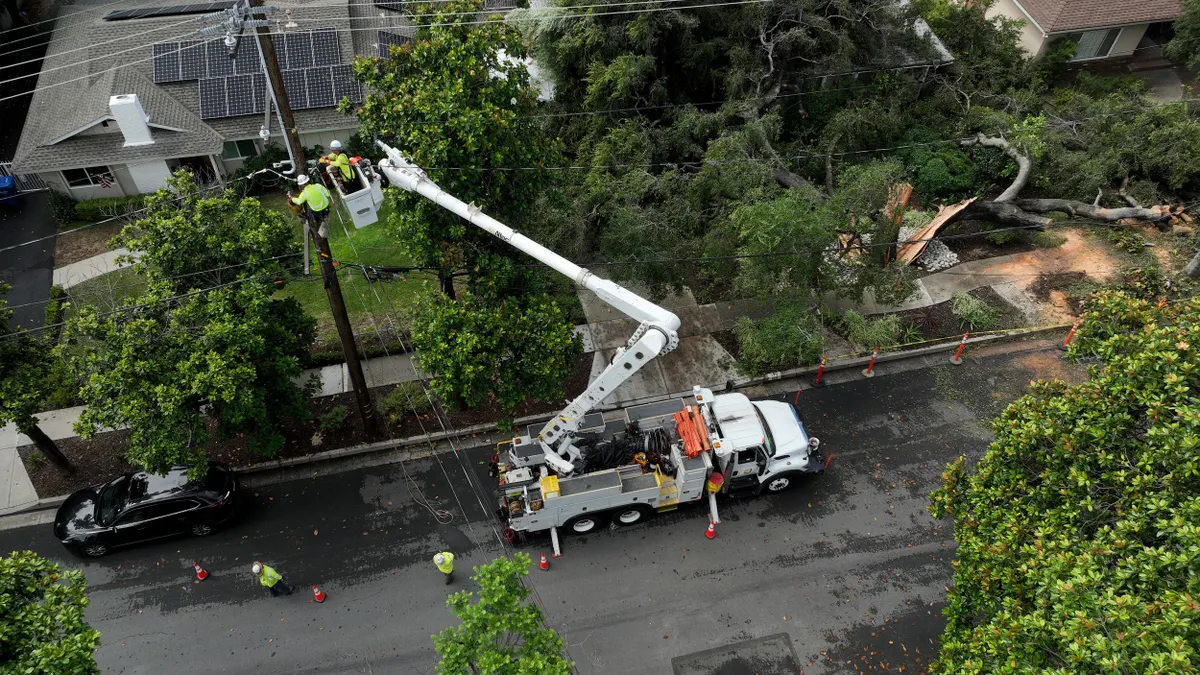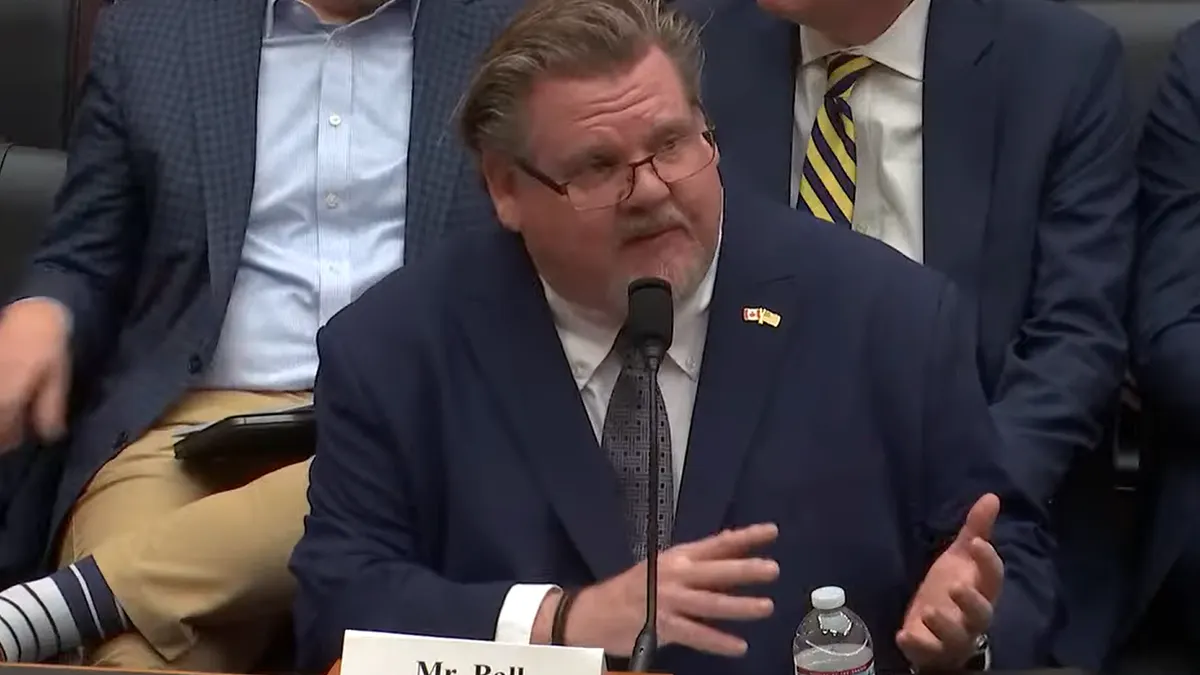Last month, the U.S. Senate defied the beltway trope of legislative gridlock that has characterized the Obama era, passing a broad energy bill in an 82-12 vote.
Approval in the Senate on April 20 marked the first time the chamber has passed a bipartisan energy bill since 2007, and national media reacted with appropriate surprise.
"It doesn't happen every day, but it happened Wednesday," the Washington Post noted in an article titled "The Senate just passed — overwhelmingly — an actually bipartisan energy bill."
But while passage of S. 2012, the Energy Policy Modernization Act of 2015, was an achievement for the senators, the bill's toughest test may still lie ahead. It must now be reconciled with a House bill that contains similar titles, but has garnered a veto threat from President Obama.
After efforts to forge a similar bipartisan coalition in the House failed last autumn, Rep. Fred Upton (R-MI), chair of the House Energy and Commerce Committee, pushed through a bill with solely GOP support. That angered many Democrats, with committee Ranking Member Frank Pallone (D-NJ) calling the measure “a partisan backward-looking piece of energy legislation” that has “an unerring devotion to the energy of the past.”
The White House announced a likely veto of H.R. 8 soon after because it “would undermine already successful initiatives," according to a statement.
The House and Senate bill outlines are similar, but there are significant differences in their provisions. A conference committee made up of members from both houses is the next formal step in the legislative process, but backroom negotiations outside of the committee could also push efforts along.
“The actual mechanics of how we will reconcile the two bills has yet to be determined,” said Rosemarie Calabro Tully, staffer to Sen. Maria Cantwell (D-WA), the ranking member on the Senate Energy and Commerce Committee who helped craft the bill.
Sen. Lisa Murkowski (R-AK), the chair of the committee and chief architect of the bill, “looks forward to chairing a conference committee,” said her staffer Michael Tadeo. “She has a great deal of faith in the regular order legislative process and is confident that all involved will work together to resolve any differences between the chambers.”
Key bill provisions
In shepherding the Senate bill to passage, Murkowski and Cantwell found the common ground House leaders could not. Even Upton recognized it as “bipartisan” and said it moved Congress “one step closer to embracing policies that say yes to energy.”
Both packages of legislation are “broad” and “touch on many subjects,” said Kirk Johnson, vice president for government relations at the National Rural Electric Cooperative Association (NRECA), the trade group for U.S. co-ops. The Senate's version is bipartisan because "leadership made a decision to seek a bill in areas where agreement was achievable and not to try to tackle every issues,” he said, echoing earlier comments from Sen. Murkowski.
There are five titles, or subjects, covered by Senate bill: Efficiency, Infrastructure, Supply, Accountability and Conservation Reauthorization. Though it covers essentially the same subjects, H.R. 8 has seven titles, including ones relating to marine hydrokinetic energy and shared renewables.
House bill
To modernize energy infrastructure, the House reports, H.R. 8 puts increased emphasis on “the transmission, distribution, and storage of energy,” according to a release from the Energy and Commerce Committee. It would reduce “government red tape” and “costly environmental regulations” impeding project siting and permitting for power grid and gas transportation projects.
The bill addresses the “barrage of regulations” and “external threats” that put security and reliability at risk with plans for greater emergency preparedness as well as advanced technologies that would protect the electricity grid from “physical and cyber-attacks, electromagnetic pulse, geomagnetic disturbances, severe weather, and seismic events.”
The bill would streamline approvals for the export of petroleum products and liquefied natural gas (LNG), which House leadership argues would "strengthen energy security." It also promises strengthened strategic energy partnerships.
Finally, H.R. 8 would eliminate “government roadblocks” to “simple and affordable” energy efficiency measures that “save money and reduce energy use.” It also targets reducing “government waste” and providing “regulatory relief for U.S. manufacturers from burdensome federal efficiency mandates.” And, it alters PURPA regulations to include shared solar.
The Congressional Budget Office (CBO) estimated H.R. 8 “would increase direct spending by $414 million over the 2016-2025 period.”
Senate bill
The Energy Efficiency title of S. 2012, the Senate reports, includes agreements on longer-term utility energy service contracts and reauthorization of many home, building, and manufacturing facility programs.
The Senate's infrastructure title has provisions to modernize the grid, improve cybersecurity, maintain the Strategic Petroleum Reserve, and grow a stronger energy sector workforce. There is also a research and development program for grid-scale storage. It funds studies, demonstrations, and planning for advanced grid architecture, microgrids, and distribution system and upgrades.
Like H.R. 8, the infrastructure title streamlines the Department of Energy (DOE) review of natural gas export projects. But the House bill limits reviews to 30 days while the Senate bill limits them to 45 days.
The S. 2012 supply title provides funding for research on nuclear fusion and fission, clean coal, methane hydrate exploration, and LNG. It supports biomass and significant growth for geothermal energy, hydroelectric power, and marine hydrokinetic energy.
The accountability title alters Department of Energy’s loan guarantee program for innovative technologies to require that borrowers provide 25% of the guarantee. It also authorizes the study of loan guarantees for fossil fuel energy, calls for interagency coordination of initiatives involving water use in energy production, and reauthorizes funding for America COMPETES Act research programs. It also imposes a requirement for Reliability Impact Statements.
The conservation title permanently reauthorizes the Land and Water Conservation Fund (LWCF). The intent is to balance the acquiring of land for infrastructure with conservation of environmental and historic sites.
S. 2012 would require $32 billion from 2016 to 2020 and $11 billion after 2020 from appropriations. Direct spending would increase by $659 million between 2016 and 2025, according to CBO.
Energy efficiency
When the Obama administration issued its veto threat, it singled out efficiency provisions in the House bill as one place for criticism.
The Senate bill, however, would answer some of those concerns about efficiency provisions, according to Lowell Ungar, senior policy advisor for the American Council for an Energy Efficient Economy (ACEEE).
“The House bill would result in more energy use rather than less energy use,” he said, while the Senate bill includes stronger overall efficiency measures.
The SAVE Act, which was added to the Senate bill late in the process, is a popular bipartisan measure that allow homeowners to finance energy efficiency projects through their mortgages, he added. It is not in the House bill.
The Senate bill would also direct the Department of Energy to strengthen building codes through a more active role in code development, adoption and enforcement, including providing grants to states and tribes for codes that increase energy efficiency. It would also boost efficiency targets for federal buildings and expand use of Energy Savings Performance Contracts.
Together, Unger said, those three programs account for more than 90% of the potential energy savings in the Senate bill, but remain absent from the House version.
No backers of the House bill interviewed by Utility Dive would comment directly on the efficiency provisions, including Reps. Ed Whitfield (R-KY) and Pete Olson (R-TX), the chair and vice chair of the House subcommittee on energy and power, respectively. Upton's office did not respond to multiple requests for comment.
But even if they are loath to talk about it, there are also efficiency provisions where the House and Senate agree, Unger said, and others where they could still find consensus. One provision – the furnace standards – is actually stronger in the House bill, he said.
There is room for cooperation, specifically on the smart building and smart manufacturing provisions and the SAVE Act, Unger said.
The energy title
While the Senate bill includes some provisions boosting research into clean energy solutions it “has become more problematic as it has moved through the legislative process,” according to a coalition of environmental groups.
The groups, including Earthjustice, the League of Conservation Voters, NRDC and the Sierra Club, do not support the Senate bill as it stands, said Marc Boom, associate director of government affairs at the Natural Resources Defense Council (NRDC)
It could have been worse by including provisions like those in the House bill that “put a thumb on the scale for fossil fuels and overrode key environmental laws,” he said. But even the Senate bill contains the biomass definition, the expansion of methane hydrate research and development, and the delay on furnace standards.
“Neither bill has a strong renewables title,” Boom said. “The House bill includes burning natural gas at the wellhead as a renewable. The Senate bill's definition of biomass could result in increased greenhouse gas emissions and its support for methane hydrates is especially of concern.”
House bill backers also declined to speak directly to the bill's energy title, but the absence of major changes in clean energy policy in either bill does not bother Chris Mele, legislative director for the National Association of Regulatory Utility Commissioners (NARUC).
“The states have been the laboratories of energy innovation,” he said. “It is wise to let the states continue doing the job.”
NRECA's Johnson agreed.
“If Congress had to go deeper into energy policy and try to make changes on things like net energy metering or bigger changes in PURPA standards, it could easily derail legislation or at least make it more challenging to find common ground," he said.
The environmental groups, though concerned about the lack of bigger energy initiatives, applauded S. 2012’s support for “new clean energy technologies like marine hydrokinetic and geothermal technologies that have yet to be commercialized on a large scale.” They also welcomed increased budgets for DOE’s Office of Science and the Advanced Research Project Agency-Energy (ARPA-E).
Natural gas
One possible place where Senate bill supporters may have leverage over the House bill backers could be on natural gas.
Because LNG export was a major priority for Sen. Murkowski, she did not push for any other significant oil and gas sector provisions. After DOE assured Sen. Cantwell it could comply with the 45 day review, she was able to support it, staffers for both senators told Utility Dive.
“DOE is on record that they can meet either [review deadline],” said Charlie Riedl, executive director for the Center for Liquified Natural Gas. “That 15 day difference is not an issue for our members and either is a major improvement on the current open-ended time period.”
Utilities need more streamlined pipeline siting “if we are going to quickly move from coal to natural gas,” said NRECA’s Johnson in defending the expedited permitting process, to which the White House objects. “We have to be able to build those pipelines.”
With the LNGCenter’s support, Upton could find reason to accede as well, Riedl said. Streamlined LNG permitting is crucial but there is room for compromise because regulatory certainty is even more critical for large-scale, capital-intensive investments.
“Having even a 45 day timeline for approval or rejection in place and knowing how to revise proposals if they are rejected will put to work capital that is waiting to move," Riedel said.
“Timely reviews of these projects is an unmitigated positive,” according to Rep. Olson (R-TX). He looks forward to hearing from his colleagues "why an additional two weeks of delay in the process is necessary," he said in an email.
The question is how to make sure LNG facility reviews are done right, Boom said, indicating why the White House could still object. “An arbitrary deadline almost guarantees they won’t be done properly. The 30 day and 45 day review periods are both too short.”
Land and Water Conservation Fund
Reauthorization of the Land and Water Conservation Fund was “a key part of why the bill was supported in the Senate,” Boom said.
During the reconciliation process, "watch the more contentious energy efficiency provisions and the permanent reauthorization of the LWCF to see if they want to come together or fight,” Ungar said.
The long floor fight over S. 2012 and the long list of amendments added to it made the bill worse that the one passed out of the Murkowski-Cantwell committee, said Sierra Club Lobbyist Radha Adhar. The main compensation was environmental protections in the Land and Water Conservation Fund (LWCF) which is, the coalition of environmental groups say in their letter, “one of the nation’s best tools for protecting our national heritage.”
It is essential, said Boom. “Without the LWCF, it would be difficult to see a path forward.”
Veto threat hangs over conference
In 2007, the last time Congress passed a bipartisan energy deal, there was an informal deal-making version of reconciliation. That means legislators have not conferenced on an energy bill since 2005, Calabro Tully said.
“A lot of the staff and some of the members have never been through the process. It will be really interesting to see how it unfolds because it won’t be familiar to a lot of the people in the room.”
Though finding common ground will not be easy, “the staff working on reconciliation are consummate professionals,” said NARUC's Mele.
“The only way reconciliation will move forward is for everybody to get a half loaf and, sometimes, one side will get a quarter loaf and the other side will get three-quarters," he added. "That is the conference process."
A major challenge could be in confronting the issues in the House bill the White House found veto worthy.
“H.R. 8 would stifle the nation's move toward energy efficiency by severely hampering the Department of Energy's ability to provide technical support for building code development and state implementation,” the White House said in its veto letter.
It would also “undercut DOE's ability to enforce its appliance standards" and weaken requirements in the 2007 energy bill for “a reduction in fossil fuel generated energy in federal buildings," according to the letter.
Another provision in H.R. 8 alters the way the capacity markets of Regional Transmission Organizations (RTOs) and Independent System Operators (ISOs) work. Capacity markets ensure system reliability but also have been a path to market for distributed energy resources and demand-side management. The White House wants them to remain under the authority of the Federal Energy Regulatory Commission (FERC).
Other provisions the White House objected to would broaden FERC authority to limit environmental reviews of natural gas pipeline applications, limit DOE reviews of natural gas export projects, undermine Federal Power Act environmental protections in hydropower project siting, and potentially interfere with the President’s constitutional authority over electric infrastructure and project siting.
Both Whitfield and Olson declined to comment on specific White House objections to the bill, but Olson emphasized how important the GOP considers the expedited siting of natural gas projects.
“Natural gas is an ‘in time’ resource,” Olson said. “Unlike coal, you can’t generally stockpile it near the power plants where it is increasingly relied upon to power our grid.”
With natural gas increasingly crucial for reliability, “it becomes critical that we have a robust network of pipeline to keep the nation’s economy at work,” Olson said. “Ensuring that FERC can wrangle the various agencies working on projects and get a decision made in a timely matter is a reasonable step forward.”
'An appetite to get something done'
It has been widely reported that Murkowski and Cantwell want to move a law to the president that he can sign. Murkowski says she wants to do so before the August recess.
There may have been a hint of common ground in Chair Upton’s acknowledgement of six standalone provisions passed by the House and included in the Senate bill. But they are minor measures, far from where the real conference action is likely to be.
The differences are clear and significant but some observers also see common ground.
“None of the energy efficiency provisions are so contentious that they give a clear political advantage to either side so it is not a matter of electioneering,” Ungar said.
If there is the will and the time for compromises the House and Senate can work things out, he added. “It depends on whether they want to find places to agree or to fight.”
The LWCF is one of the issues that will require a lot more negotiating than other provisions, Johnson said.
There are “major concerns that would negate any of the positive provisions of the bills,” Boom said.
The bills are far apart on the permanent re-authorization of the LWCF and neither bill has a strong renewables title, he added.
“We think there is a willingness to come to agreement on the LNG issues but there are differences on many other issues,” Riedl acknowledged. “I would like to think there are interested parties that stand to benefit both on the hill and in the private sector who could apply positive pressure to reach bipartisan cooperation.”
The key driver for both sides, he added, is the desire to get things done and the energy bills offer that opportunity.
“There is probably an appetite to get something done,” Boom agreed. Because the House has been unable to move basic legislation, “it would not surprise me if there was an attempt to do that by building off the Senate bill.”
After 25 years of observing and being part of conference committees, Johnson still finds it hard to predict how they will go, he said. “The art of compromise is tough. Sometimes it means getting rid of the difficult issues and sometimes it means making real compromises.”
Senator Murkowski’s push to get to a law has been exceptional, Mele said. “In an election year, this could benefit both parties by demonstrating Congress isn’t dysfunctional. They say politics is the art of the possible. But legislation is the art of the doable. Possible and doable are two very different things.”





















